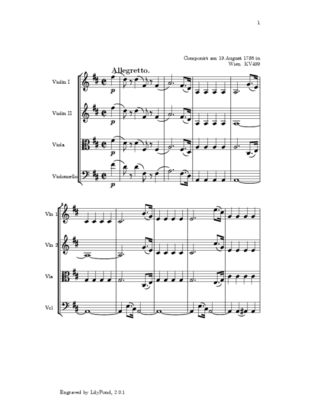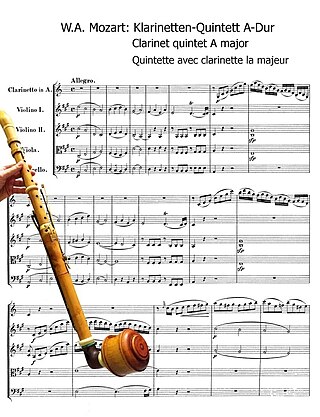Movements
The work is in standard four movement form:
- Allegro moderato
 in B-flat major
in B-flat major - Adagio
 in E-flat major
in E-flat major - Menuetto ma Allegretto 3
4 in B-flat major, with trio in F major - Allegro 2
4 in B-flat major
The String Quintet No. 1 in B-flat major, K. 174, was written by Wolfgang Amadeus Mozart in December 1773. Unlike Mozart's other viola quintets, which are scored for two violins, two violas and cello, this early work is scored for two violins, two violas and basso. It is inspired by Michael Haydn viola quintets in C major (MH 187) and G major (MH 189), written earlier in the same year.
Mozart composed this quintet a few months following the composition of the Viennese Quartets, K. 168–173 – indeed this work immediately follows that set in the first edition of the Köchel catalogue.
The work is in standard four movement form:

The term string quartet refers to either a type of musical composition or a group of four people who play them. Many composers from the mid-18th century onwards wrote string quartets. The associated musical ensemble consists of two violinists, a violist, and a cellist. The double bass is almost never used in the ensemble mainly because it would sound too loud and heavy.

The String Quartet No. 20 in D major, K. 499, was written in 1786 in Vienna by Wolfgang Amadeus Mozart. It was published by – if not indeed written for – his friend Franz Anton Hoffmeister. Because of this, the quartet has acquired the nickname Hoffmeister. Hoffmeister had started issuing a series of chamber-music publications in 1785, including Mozart's K. 499 as well as Joseph Haydn's String Quartet No. 35, Op. 42.
E-flat major is a major scale based on E♭, consisting of the pitches E♭, F, G, A♭, B♭, C, and D. Its key signature has three flats. Its relative minor is C minor, and its parallel minor is E♭ minor,.
D minor is a minor scale based on D, consisting of the pitches D, E, F, G, A, B♭, and C. Its key signature has one flat. Its relative major is F major and its parallel major is D major.

Franz Schubert's final chamber work, the String Quintet in C major is sometimes called the "Cello Quintet" because it is scored for a standard string quartet plus an extra cello instead of the extra viola which is more usual in conventional string quintets. It was composed in 1828 and completed just two months before the composer's death. The first public performance of the piece did not occur until 1850, and publication occurred three years later in 1853. Schubert's only full-fledged string quintet, it has been praised as "sublime" or "extraordinary" and as possessing "bottomless pathos," and is generally regarded as Schubert's finest chamber work as well as one of the greatest compositions in all chamber music.

Wolfgang Amadeus Mozart's Clarinet Quintet, K. 581, was written in 1789 for the clarinetist Anton Stadler. A clarinet quintet is a work for one clarinet and a string quartet. Although originally written for basset clarinet, in contemporary performances it is usually played on a clarinet in A. It was Mozart's only completed clarinet quintet, and is one of the earliest and best-known works written especially for the instrument. It remains to this day one of the most admired of the composer's works. The quintet is sometimes referred to as the Stadler Quintet; Mozart so described it in a letter of April 1790. Mozart also wrote a trio for clarinet, viola and piano for Stadler, the so-called Kegelstatt Trio, in 1786.
The Divertimento in E♭ major, K. 563, is a string trio, written by Wolfgang Amadeus Mozart in 1788, the year in which he completed his last three symphonies and his "Coronation" Piano Concerto. It is his last divertimento and different from his other divertimenti not only in its instrumentation but also in its compositorial ambition and scope.
The String Quintet No. 4 in G minor, K. 516, written by Wolfgang Amadeus Mozart, is like all of Mozart's string quintets a "viola quintet" in that it is scored for string quartet and an extra viola . The mood of the piece is dark and melancholic, typical of Mozart's G minor works.
The String Quintet No. 3 in C major, K. 515 was written by Wolfgang Amadeus Mozart. Like all of Mozart's string quintets, it is a "viola quintet" in that it is scored for string quartet and an extra viola.
The String Quintet in E♭ major, Op. 97, B. 180, was composed by Antonín Dvořák during the summer he spent in Spillville, Iowa in 1893. It is a "Viola Quintet" in that it is scored for string quartet with an extra viola. It was completed in just over a month, immediately after he wrote his American String Quartet. Like the Quartet, the Quintet finely captures the inflection of Dvořák's Bohemian idiom with American inspirations. The Quintet was premiered by the Kneisel Quartet in New York on 13 January 1894 along with the second performance of the Quartet and very favorably reviewed, as comparable to Mozart. The reviewer noted that the Quintet was "of the kind about which a commentator may write a small volume without exhausting his admiration or fully describing their beauties".
The String Quintet No. 5 in D major, K. 593 was written by Wolfgang Amadeus Mozart in 1790. Like all of Mozart's string quintets, it is a "viola quintet" in that it is scored for string quartet and an extra viola.
The String Quintet No. 6 in E-flat major, K. 614, was completed by Wolfgang Amadeus Mozart on April 12, 1791. It is Mozart's last major chamber work. Like all of Mozart's string quintets, it is a "viola quintet" in that it is scored for string quartet and an extra viola
The String Quintet No. 2 in C minor, K. 406/516b, was written by Wolfgang Amadeus Mozart in 1787. Like all of Mozart's string quintets, it is a "viola quintet" in that it is scored for string quartet and an extra viola. Unlike his other string quintets, however, the work was not originally written for strings. Having completed the two string quintets K. 515 and K. 516, Mozart created a third by arranging his Serenade No. 12 for Winds in C minor K. 388/384a, written in 1782 or 1783 as a string quintet. Although by then Mozart was entering each new work into his catalogue of compositions, he did not enter this quintet, perhaps because it was an arrangement rather than a new work.
The Griller String Quartet was a British musical ensemble particularly active from 1931 to c.1961 or 1963, when it was disbanded. The quartet was in residence at the University of California at Berkeley from 1949 to 1961. It performed a wide repertory, including works written for it by Ernest Bloch, Darius Milhaud, and Arnold Bax.
The Perger-Verzeichnis is a thematic-chronological catalogue of instrumental compositions by Michael Haydn, compiled by Lothar Perger in 1907. Like Ludwig von Köchel's catalog of Mozart's compositions, Perger's catalog uses a single range of numbers, from 1 to 136, but like Hoboken's catalog of Joseph Haydn's music, groups the pieces first into categories and then sorts them chronologically.
Wolfgang Amadeus Mozart's String Duo No. 1 in G major for violin and viola, K. 423, was written in 1783. It was the first of two duos that Mozart wrote to complete Michael Haydn's set of six for the Archbishop Colloredo.

The six string quartets Op. 20 by Joseph Haydn are among the works that earned Haydn the sobriquet "the father of the string quartet". The quartets are considered a milestone in the history of composition; in them, Haydn develops compositional techniques that were to define the medium for the next 200 years.

The Piano Quartets, WoO 36, by Ludwig van Beethoven are a set of three piano quartets, completed in 1785 when the composer was aged 14. They are scored for piano, violin, viola and cello. He composed a quartet in C major, another in E-flat major, and a third in D major. They were first published posthumously in 1828, however numbered in a different order: Piano Quartet No. 1 in E-flat major, Piano Quartet No. 2 in D major, and Piano Quartet No. 3 in C major.

Wolfgang Amadeus Mozart's Horn Quintet, K. 407 (386c), was written in 1782 for the soloist Joseph Leutgeb. The work calls for one French horn, one violin, two violas and one cello, differing from the usual two violins with the conventional string quartet.